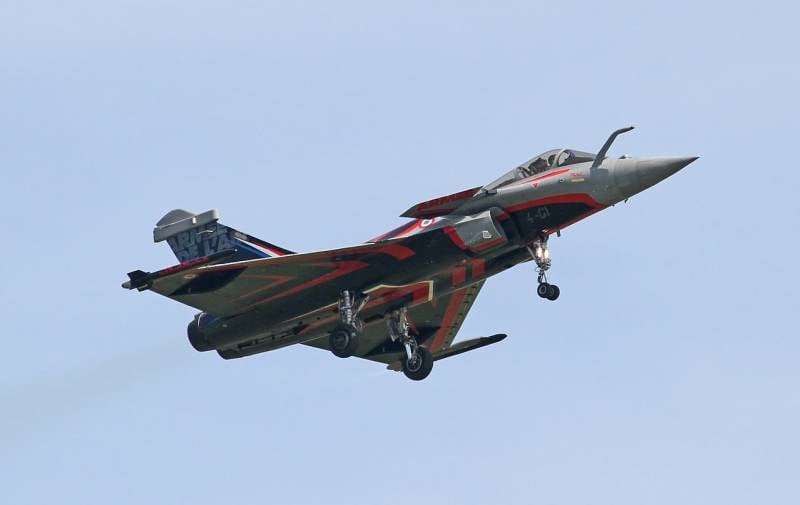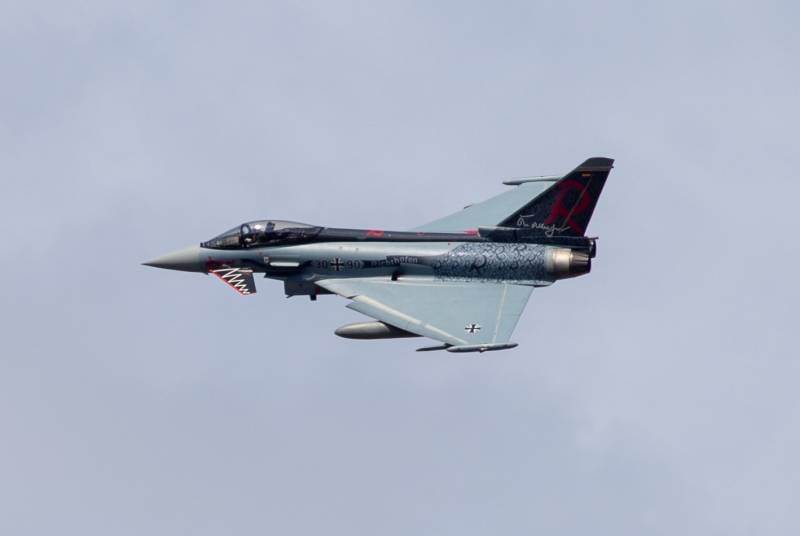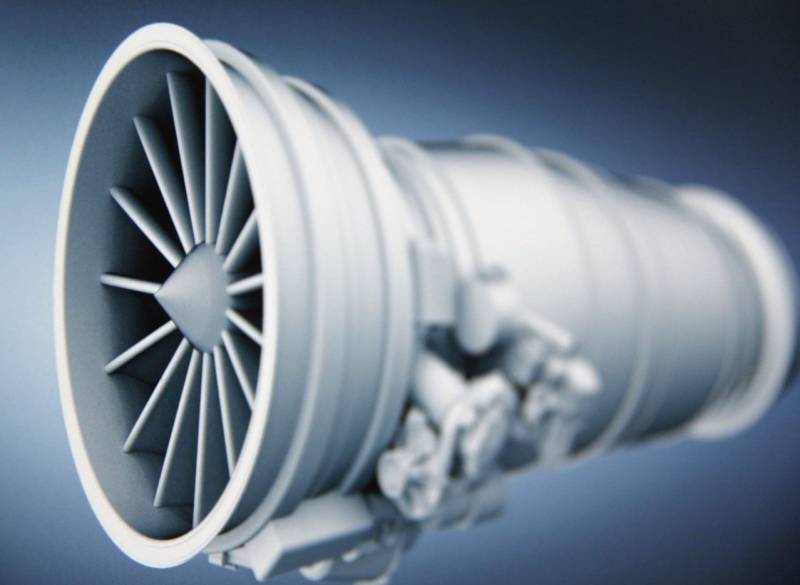SCAF project. Fighter of the future for France and Germany
Future and politics
At present, the air forces of Germany and France are armed with aircraft of various types, both relatively old and new. According to current plans, the operation of the most new machines will be able to last for a long time. The equipment resource will be extended as part of the repair, and the upgrade will ensure compliance with current requirements. However, in the late thirties there will be a need for completely new aircraft, which will have to replace the existing equipment.

Fighter Dassault Rafale French Air Force. In the future, it is planned to replace it with SCAF aircraft.
Both countries have long preoccupied themselves with the issue of the further development of combat aviation, but real results are not yet available. In addition, some attempts to create completely new designs have dubious prospects. Thus, over the past few years, France and the UK have been working on a joint project of the FCAS / Future Combat Air System (“Air Combat System of the Future”). As far as is known, so far only a few studies have been carried out under this program, and technical design is still far away.
At the same time, the future of the FCAS program was in doubt. The notorious "Brexit" can interfere with the effective cooperation of British and French aircraft manufacturers. In addition, London decided to reduce the cost of a promising project, while Paris is in no hurry to abandon it. What the future of the FCAS project will be is unknown. So far there are grounds for both optimism and negative forecasts. The situation should be clarified in the foreseeable future.
The future of the FCAS project depends on a number of specific factors. At the same time, the further development of the French Air Force is directly connected with it. Official Paris is not satisfied with such risks, which leads to the need to launch new programs for the development of aircraft. In addition to the project under development, FCAS was offered to launch a new program of a similar purpose. To reduce risks, it was proposed to start cooperation with another country.
New project
Back in the middle of 2017, top executives in France and Germany announced their intention to start developing another aircraft project for tactical aircraft. At that time, it was claimed that all the main enterprises of the aircraft industry and related areas from the two countries would take part in the creation of the new fighter. It was assumed that the main work on the project will begin only in the future. Serial production of the new aircraft will be able to start no earlier than the second half of the thirties.
A promising model of aviation technology was named SCAF (Système de Combat Aérien du Futur - “Air combat system of the future”). It should be noted that France, launching another project with the participation of a new foreign partner, retained the existing name. The SCAF and FCAS programs actually have the same name, but in different languages.
In early April, 2018, it became known that the two countries launched the new project. After the talks, the heads of the military departments of the two countries announced the imminent start of the preliminary elaboration of the project. For obvious reasons, representatives of the developing countries are not yet ready to reveal the technical appearance of promising technology. At the same time, those or other wishes of customers were repeatedly indicated. A number of objective factors led to the fact that future operators of the SCAF aircraft are placing the highest demands on it. Plans for this project are particularly bold.
It is planned that Airbus and Dassault will take over the bulk of the work on the SCAF program. At the same time it is planned to attract a lot of other organizations to the works. First of all, they will have to develop and supply various components for advanced equipment. For example, the company MTU Aero Engines looks like a likely supplier of power plants. This year, she presented a concept project of a new turbojet engine for the FCAS aircraft, which can also be used in the SCAF program.
The exact schedule of the new program, apparently, has not yet been determined. In addition, the final list of participants is unclear. To date, only individual assessments of one kind or another have been expressed, as well as opinions on various issues. Apparently, unequivocal answers to relevant questions will appear only in the future. In the meantime, various and interesting forecasts are presented.
So, in July of this year, at the Farnborough Air Show, bold statements were made about the future of the SCAF project and one of the parallel developments. Not so long ago, the UK announced the launch of a new generation of its own aircraft Tempest, which should become a direct competitor to FCAS. The executive director of the Eurofighter consortium, Volker Finger, suggested that in the future these projects will be merged into a common program. FCAS / SCAF and Tempest will eventually become one plane, and European countries will not disperse efforts on several different projects.
The head of the organization also spoke about plans for the development of the existing Eurofighter Typhoon fighter. In the new versions of this machine will be introduced promising solutions and technologies that positively affect the characteristics. The consortium hopes that its new developments, planned for implementation at Eurofighter, will be applied in the future to the SCAF project.
Plans for the future
Part of the plans of Paris and Berlin has already been announced. As it turned out, the project Système de Combat Aérien du Futur is being developed with a reserve for the distant future. No one plans to rush to his development and try to make a new fighter as soon as possible. Preliminary study, design work and further tests with the preparation of mass production will stretch over the next two decades. Prior to the completion of all the necessary work, the air forces of the two countries will have to use the existing equipment, carrying out timely repairs and upgrades.
The coming years are supposed to be used for theoretical study of the future aircraft shape. The entire first half of the twenties will go to discuss the requirements and the formation of common features of a promising machine. Design is planned to start only in 2025 year. This stage of the program will take several more years, and in the first half of the thirties an experienced SCAF type fighter is expected to appear. Flight tests will again take several years. Start of mass production and transfer of equipment to the troops are expected no earlier than mid-thirties.
Such deadlines for the implementation of the program lead to curious consequences. According to customers and future developers, the goal of the SCAF program should be the development of the sixth generation fighter. They believe that by the 2040, the modern fifth generation will be morally obsolete, and new threats will appear in the air. In this regard, the fighter for the distant future should immediately relate to the advanced generation. In this context, it is worth recalling that European countries have not been able to create their own versions of the fifth-generation fighter.
The desire to develop a sixth-generation machine raises certain questions that remain unanswered. For example, one of the signs of the future sixth generation is the possibility of creating an unmanned version of a fighter. However, France and Germany, it seems, do not yet know for themselves how their prospective SCAF will be managed. Other features of the new aircraft remain uncertain.
Although some technical clarity can be present only in the context of the power plant. This year, MTU Aero Engines for the first time presented a concept project of a promising turbojet engine designed for an FCAS aircraft. Apparently, such a motor without significant modifications can be used in the French-German project SCAF. The project is still the working title of NEFE - Next European Fighter Engine (“Engine for the next European fighter”).
The goals of the NEFE project are obvious. The new engine should develop greater traction with improved efficiency. It is also necessary to reduce the cost of development, production and operation. An increase in the total and between-repairs resource is expected. The proposed design tasks are proposed to be solved with the help of already known and completely new ideas. In particular, the stated use of "bionic design" of some parts. It is planned to use the so-called turbine as part of the turbine. Ceramic-based matrix composites, which will provide an increase in gas temperatures with a corresponding increase in thrust.
From the point of view of avionics, the new fighter must meet all modern requirements, and in some cases be ahead of them. It is required to ensure the possibility of observing the surrounding air or ground situation with the help of various systems. Also, the aircraft must be able to transmit and receive data on targets. SCAF will solve combat missions both alone and as part of aviation groups, including mixed ones.
The fighter must interact with other equipment in different ways. In addition to the traditional collaboration with other manned aircraft, it is expected that interaction with unmanned aerial vehicles will be possible. The sixth generation fighter must be able to control several UAVs and distribute different roles between them as part of the overall combat mission.
It is assumed that the machine will be able to deal with air targets in the framework of interception or gaining air superiority. The possibility of working on ground targets should also be provided. The nomenclature of armaments should include guided and unguided weapons of various types. Weapon must comply with the requirements relevant at the time of the start of service of the aircraft. Thus, it is quite possible that bombs and missiles that are not yet in existence will be under the wing or in the internal freight-handling compartments of the SCAF fighter.
Plans and reality
However, it is necessary to take into account that even the main provisions of the future project have not yet been determined. It is planned to spend the next few years on the formation of requirements and the determination of the overall appearance of a prospective aircraft, and results of this kind will appear only by the mid-twenties. Only by 2025, it will become clear how European countries see their new fighter. Naturally, such results will be known only under the condition that France and Germany will not abandon their project Système de Combat Aérien du Futur.
The events of recent years and the regular change of plans of different countries may be cause for concern about the future of the SCAF project. Customer opinions are constantly changing; the political situation changes and other factors appear that can influence the course of various promising projects. For example, there is a risk of rejection of a new aircraft in favor of the purchase of foreign technology. Of all these facts there is a very harsh situation that reduces the likelihood of successful completion of the project.
In other words, in the next two decades, Paris and Berlin may change their mind and at any time abandon the SCAF program in favor of other projects. Such a decision may contribute to difficulties in the development of the project or its various components, financial problems or differences in the views of the military from different countries. Joint projects of European development have already encountered such problems, and there is no guarantee that the new program Système de Combat Aérien du Futur will be able to reach the desired final.
The new international development program of the promising sixth generation fighter is of great interest and is of particular importance to the air forces of Germany and France. Nevertheless, it is already clear that she will have to face a variety of difficulties. The future aircraft, which is to appear in the thirties, should have high performance and meet the requirements of its time. But long before the first flight, he may face a variety of difficulties.
Whether European designers will be able to cope with the difficulties of an economic, technical and political nature - time will tell. The SCAF / FCAS program has certain chances of success. However, even in the case of its successful continuation, the air forces of several countries will still have to maintain modern fighters of an obsolete generation for a long time.
On the materials of the sites:
https://janes.com/
http://air-cosmos.com/
http://latribune.fr/
http://opex360.com/
http://militaryparitet.com/
https://globalsecurity.org/


Information